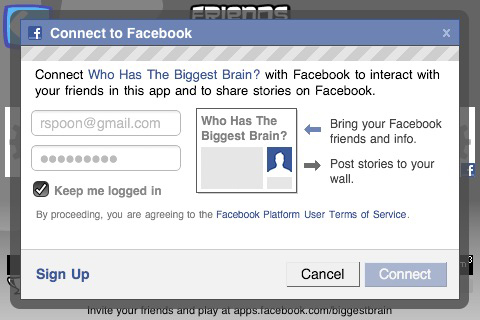Om Malik谈论提升手机应用程序吸引力的三大要素
Om Malik根据自己逛纽约某制衣小店的所看所想,建议开发者通过三个方面提升手机应用的吸引力,以下是游戏邦编译的论述文章:
我上次去纽约时,曾驻足西村制衣人Bruno Cucinelli的小店。在这个豪华奢侈品牌经销店充斥的城市中,这个小店带来美妙且好似田园风情的购物体验。我去了好几次,店中的衣物不多却井井有条。更重要的是,展示的每样商品都能给顾客带来最大的视觉冲击。
走在小店过道上欣赏挂在你右侧的衣物,到尽头反转走中间的过道,只需几分钟时间就可以完全了解摆放着的衣物。只要你看上店中的衣物,随时可以和销售人员攀谈。如果没有喜欢的东西,你可以继续前行寻找。在这种小店中花的时间并不多,更重要的是,不会令人难以取舍,让购物显得轻松。
我认为,自己在Cucinelli店铺中的经历犹如良好的手机应用体验。为什么呢?因为在购物过程中,店铺几乎不会让人产生冲突和抉择的想法。同理可证,为在逐渐增加的手机应用(游戏邦注:纷繁的应用让用户身心俱疲。)脱颖而出获得成功,手机应用本身应该减少冲突。
为提升用户体验效果,应用所能采取的方法并不多。但最先都需要突破现今移动电话和智能手机体验的三大主要限制:网速(游戏邦注:运营商对此发表的言论有限,而且对高流量下载行为没有丝毫帮助。)、屏幕和有限的移动手势。
速度越快越好
让智能手机有机遇飞速发展的用户需求也成为手机应承担的责任。无论你使用何种设备,即便是最优良的3G网络也会有带宽限制。尽管将来更快的无线宽带技术可以解决这个问题,但作为今日的应用开发者,你应该将网速的挑战铭记在心。提升应用速度正是开发者应该做的事,这不仅代表应用的下载速度要快,还包括运行速度。尽量优化用户使用应用核心价值的速度,美化界面等特征不是优化的重点所在。
Instagram联合创始人Kevin Systrom最近告诉我说,优化应用速度是他着手实施的重要产品决策。认识到无线网络的上传速度不佳,他们决定将照片大小限制在可快速上传的范围内,同时保证其在智能手机屏幕上看起来让人称心如意。他声称,速度快会让消费者更加愉快,他们也会更经常使用这款应用。现在看来,他们的想法是对的。
其他应用公司也觉察到,速度是提高用户使用率的关键因素。Foursquare联合创建者Dennis Crowley近期表示,公司正开发小版本应用以加快登录速度,将登录时间从20秒减少至5秒。登录越容易,速度越快,用户使用Foursquare的可能性越大。这并非史无前例之举,Google将搜索速度作为提高用户使用其搜索引擎可能性的诱饵。如果搜索结果显示速度很快,即便首次尝试未看到所要的内容,他们也很可能再次搜索。
应用的简易程度
数个月前,我曾经撰文探讨过网络服务吸引消费者的原因所在。在我罗列的三个因素中,由于手机屏幕尺寸和触屏手势有限,“清晰的目的”和“简单的使用方法”可极大优化手机应用。让用户保存文件留待闲时阅读的应用Instapaper便是有着清晰目的和简约使用方法的绝佳例证。
从用户下载应用后打开那一刻起,使用方法的简洁性和清晰目的便开始发挥作用。注册应用或服务应该要在数秒内完成,而不是数分钟。我喜欢Beluga的原因之一就是它注册过程简单。不要在用户注册时提许多问题,输入邮箱、用户名和密码即可。
使用Facebook Connect是种更好的方法,可避免注册应用引起的冲突。如果账户遭到攻击,所有这些应用都可能被注销,数月前我曾面临这种困境。但如果开发者使用Facebook Connect,就不会存在这样的危险。Daniel Raffel此前是某著名盗号公司的联合创始人,他将Facebook Connect描述为“移动网络的润滑剂”。现在,大部分人都有Facebook账户,使用Facebook用户名和密码既可避免注册服务带来的麻烦,也无需再去记住新密码。
上述做法很关键,无论你操作多么熟练,在智能手机上打很多字都是件费时费力的事情。消费者下载和注册服务所花费的时间越少,他们就能越快体验到你的应用。开发者需要记住,在这个应用泛滥的世界中不存在第二次机会。
回乡数天后,我发表了为何提供给用户的应用(游戏邦注:包括其他互联网产品)需要开始将“愉快”的想法融入其中。速度、注册和使用方法简单以及关注核心价值可以提升应用的“愉快”程度。也正是这三个原因让我不断重返Cucinelli的店铺。上次旅行时,我几乎都想买上一件羊毛衫,无奈没有适合我的型号。(本文为游戏邦/gamerboom.com编译,转载请注明来源:游戏邦)
What Makes Apps Delightful?
On my last visit to New York, I stopped at apparel maker Bruno Cucinelli’s store in the West Village. In a city of opulent, luxury-brand outlets, this tiny outpost was perhaps one of the most ideal and idyllic shopping experiences. I go there again and again. There is little or no clutter, a limited set of apparel options and more importantly, everything is laid out for maximum impact.
You enter the store, walk down an aisle looking at the clothes hanging on your right (men’s wear), reach the end of the store, turn around, check out the middle aisle, and take in what’s on display. The whole process takes a few minutes. Once you’re done with the walk-through, you zero in on one or more items on display, and engage with the sales person. If nothing catches your fancy, you move on. It doesn’t take much time, and more importantly, it involves fewer decisions on my part, making shopping less of a chore.
That Cucinelli store is a great metaphor for what I think is a good mobile app experience. Why? Because the store had little or no friction when it comes to the shopping process. Similarly, in order to be successful and stand out among the growing number of mobile apps demanding our attention, the mobile apps have to have little friction.
There are few ways an app can work toward a better experience. It all starts with overcoming three major constraints with today’s mobile and smartphone experience: Network speeds, despite all the talk from carriers are limited and thus not conducive to heavy download activity; Limited screen real estate, which puts premium on every pixel; Finite number of mobile gestures (that don’t involve using the keyboard.)
Faster Is Better
The same demand that makes smartphones an exciting opportunity also turns into a liability. It doesn’t matter what device you use; even the best of 3G networks has bandwidth challenges. And while at some point in the future, the faster wireless broadband technologies are going to solve the problems, today as an app developer, you have to keep the challenges of network speeds in mind. What you have to do is build apps that are fast. By that, I mean not only does the app load fast, but also has a lightweight experience. It’s optimized less around cool features and more around the speed with which you can use an app’s core value proposition.
Kevin Systrom, co-founder of Instagram, recently told me one of the crucial product decisions his start-up made was optimizing around speed. Knowing upload speeds on wireless networks were bad, they decided to limit photo size to small enough for a quick upload, yet looked gorgeous on the smartphone screen. The speed, he contended, would make for happier customers, who in turn would use the app more. And they were right.
Other app companies are finding out that faster execution is key to higher engagement. Foursquare Co-founder Dennis Crowley, speaking at a recent event, said the company was building a lighter version of the app for faster check-ins and to reduce the check-in time from 20 seconds to five seconds. The easier and faster it is to check-in, the more likely one is to use Foursquare. This isn’t a radically new notion; Google has used the speed with which it can serve up search results as a lure for getting people to use its search more often. Since the search results show up blazingly fast, one is likely to search again, even if the first try doesn’t yield results.
Size Matters
A couple of months back, I wrote about what makes a hit (consumer) Internet service. Of the three reasons I listed, “clear purpose” and “simple to use” were ones that make perfect sense for mobile apps, given the limitations of screen size and touch-screen gestures. A good example of an app with clear purpose and simplicity? Instapaper: the save-and-read-later app.
That simplicity and clear purpose begins from the very second someone opens the app after downloading. Signing up for your app/service should be done within seconds, not minutes. One of the reasons why I loved Beluga was that it probably had one of the simplest sign-up processes. Not many questions asked — enter an email, get a username and password, and you’re ready to go.
Better yet, use Facebook Connect, which removes any friction that there is in terms of sign-ups. There is a big risk of you being logged out of all these apps if your account gets hacked, like mine was a couple of months ago. But app developers are embracing the Facebook Connect, and are well aware of such risks. Daniel Raffel, co-founder of a yet-to-be-named stealth mode company, described Facebook Connect as the “K-Y Jelly of the mobile web.” By now, most, if not all, people have Facebook accounts, so by entering their username and password, the hassle of signing up a service and remembering another password is also eliminated.
This is crucial. Too much typing on a smartphone can be arduous and time-consuming, no matter how deft you are. The less time spent between download and using the service, the faster customers can start to experience your offering. Remember, there are no second chances in today’s app-infested world.
A few days back, I wrote about why apps (and other products) have to start building the idea of “happiness” into their offerings. Speed, simple and easy sign-ups, and single focus on core values only add to that “happiness.” Those three qualities are the reason why I keep going back to that Cucinelli store. On my last trip, I almost bought a cardigan — but they didn’t have it in my size. (Source: Gigaom)










































 闽公网安备35020302001549号
闽公网安备35020302001549号